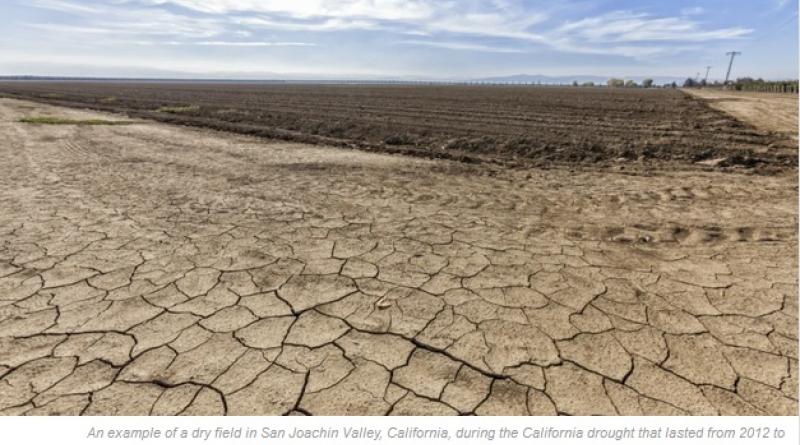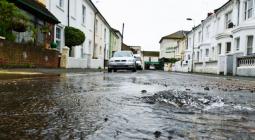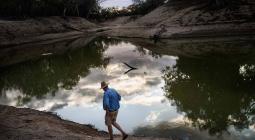Groundwater Sustainability Is Needed More Than Ever

he immediate emergency of COVID-19 has been a powerful reminder that the most valuable things in our lives are our families, friends, and the welfare of our communities.
The current pandemic is a threat to those closest to us today in a way that presages what we will experience on an accelerating basis due to the climate emergency. In a place like California's San Joaquin Valley (SJV), Latinos account for 70 percent of COVID-19 cases, even though they represent 42 percent of the population. Improving access to clean and affordable water even as the pandemic grows more urgent, is critical to reducing the types of burdens worsened by the COVID-19 crisis. Continuing the hard work on groundwater sustainability required by the Sustainable Groundwater Management Act (SGMA) could lessen the impact of future crises in the valley. The low level of preparation communities have experienced around the pandemic, echos what these same communities face for water management on a daily basis and will face with future climate change threats unless fundamental changes are made locally.
Thousands of People in the SJV Live Without Reliable Access to Water.
California is the wealthiest state in the most prosperous country in the world, and yet, there are close to one million people living without reliable access to safe, clean, and affordable drinking water. Most of these people are concentrated in disadvantaged communities in the SJV. California identifies disadvantaged communities as areas that experience disproportionate levels of a combination of poverty, air and water pollution, high unemployment, and high rates of cardiovascular diseases and asthma. According to a report from the UC Davis Center for Regional Change, residents in these communities are over 60% Hispanic.
The SJV is one of the most productive agricultural regions in the world, producing more than half of California's agricultural output with over 200 different crops and annual revenue of about 20 billion US dollars. The astonishing volume of water that agriculture requires has led to over-exploitation of groundwater and the continuous lowering of groundwater levels that has impacted water quality and quantity.
Groundwater is the primary source for household water needs and agricultural water supply. Yet, thousands of people are unable to drink and use the water in the SJV, because there are multiple contaminants in it. Some of the water pollution comes from natural sources and includes substances like arsenic, but most of it has emerged due to agricultural practices. These contaminants include pesticides and nitrates, which are linked to cancer, birth defects, and blue baby syndrome.
In years with average precipitation, water flowing in California's rivers from rain and melted snowpack meets about 60 percent of the state's water demand and groundwater meets the remainder. However, during dry years water supply sources shift and put severe stress on groundwater levels. During the California drought from 2012 to 2016, groundwater use, mostly from agricultural water pumping, grew to 80 percent in some regions of the SJV increasing overdraft. Groundwater overdraft occurs when water extractions exceed recharge into an aquifer. An analogy is your bank account; extract more money than is put in, and your account will go dry. Aquifers are like a shared account, with some people taking out more than others. Consequently, thousands of domestic wells ran dry, unable to reach water due to lowered groundwater levels, in large part due to increased agricultural water pumping, and affecting thousands of people across the valley.
We think about drought as standalone events, but in reality, human actions triggered by droughts can have effects that continue long after the drought has ended, like permanently lowering the water table. In the SJV, the last drought has permanently reduced the capacity of some aquifers because overdraft left air in between soil particles instead of water, and the soils subsided eliminating the space for water storage. Overdraft also leads to infrastructure damage from land subsidence, that is when the ground levels drop, plus reduction of surface water, and an increase in water quality problems. That range of concerns brought by overdraft formed the basis of SGMA.
Groundwater Sustainability Plans Could Fix Part of the Problem but Are Currently Inadequate.
SGMA passed in 2014 and is the first legislation in California to mandate sustainable management of groundwater resources. SGMA is intended to bring about groundwater sustainability by the year 2040. Local water agencies describe the means to achieve this goal in their Groundwater Sustainability Plans (GSPs). For those interested in the details of SGMA, here is a thorough description of it. The focus of this post is on the latest developments.
The 21 most critically over-drafted groundwater basins submitted their GSPs at the beginning of the year and are now under review by the California Department of Water Resources (DWR). External reviews of these plans argue that some of them do not sufficiently address current and future impacts on disadvantaged communities. For example, the Groundwater Leadership Forum (a group of organizations funded by the Water Foundation focused on ensuring the success of SGMA and of which UCS is part) also reviewed several GPSs and found gaps in how drinking water, climate change, stakeholder involvement, managed wetlands, and groundwater-dependent ecosystems were addressed in the plans. The Public Policy Institute of California (PPIC) reviewed 36 plans submitted for basins overlapping the SJV. They found Kings Basin (surrounding Fresno) stands out for having the highest number of domestic wells that may go dry, about 600 of them, under the proposed water level sustainable thresholds and yet the local groundwater plan considers that an insignificant impact from continued overdraft. This is concerning and unacceptable. Public comments can be consulted in the SGMA portal from DWR.
I, and many others are concerned that multiple GSPs have questionable integrations of climate change projections. GSPs are considering numerous projects to tackle their local overdraft, yet they are not planning for the uncertain future that climate change is bringing. To reduce some of the vulnerabilities that we see now, GSPs need to integrate climate change and show benefits on the range of future scenarios.
Another concern is that on May 14, the Governor announced a $40 million cut on funding for SGMA. Part of the money was expected to support 37 new staff positions at DWR to uphold its statutory obligation on reviewing GSPs. While the budget still allocated $26 million of existing Proposition 68 bond funds to help with implementation projects in critically overdraft basin, it is unlikely that DWR will have the capacity to review the GSPs thoroughly. However, the governor's budget did prioritize safe and affordable drinking water and the State Water Board approved $130 million for 2020-2021 to projects that support such objective on vulnerable communities.
Without Bold Action and Preparation, Climate Change Threats May Bring Similar Impacts to Those of COVID-19.
The lack of drinking water causes many residents in the valley to rely on bottled water as their primary source for drinking and cooking. Panic buying at the beginning of the pandemic left stores across the valley without bottled water. In the case of COVID-19, unsafe and unreliable access to water has endangered a multitude of low-income communities by preventing them from performing protective, hygienic acts, handwashing, in particular, and forcing them to go to public water supply kiosks. As we've all learned, hand washing is one of the most necessary measures needed to slow and stop the spread of a virus. Without a correct implementation of groundwater sustainability plans under SGMA, many of these risks will continue.
Shelter in place orders resulted in people losing their jobs and hence, their source of income and being unable to pay utility services. Small utility services were also impacted because of low economic margins of operations in which small drops in income translate to being unable to provide service. Fortunately, many organizations and individuals wrote a letter to Governor Newsom that prompted him to issue an executive order protecting homes and small businesses from water shutoffs.
We now have the opportunity to give meaning to these current hardships by learning from them to prevent hardships from climate change. Climate change is a threat intensifier. In this case, the threat is a virus, and historical inequities and water vulnerabilities increased its impact on the most vulnerable among us. An example of the unpreparedness of the system to support our vulnerabilities during times of crisis is seen in the case of school children who rely on school lunches as their main meal of the day but are now unable to access this resource due to school closures. Some farmworkers, while cataloged as 'essential' by the federal government during this crisis, are undocumented and were not part of the stimulus package. The height of irony is farmworkers struggled with access to food distribution when they needed it.
There Is No Scenario Where Water Is Not Absolutely Necessary to Lessen the Impacts During a Crisis.
One of my colleagues wrote that moments of crisis often expose the weak points of a system. In the SJV, the weak points of the water system have been exposed for years and won't be strengthened without managing water resources sustainably. This is evidenced by the number of people in the SJV without access to safe, clean, and affordable drinking water. Considering that about 95% of valley residents depend on groundwater for at least part of their water, it is critical that GSPs explicitly include strategies for addressing some of the current and future water issues in the SJV.
Numerous, various kinds of climate threats will come, whether they develop as floods, heatwaves, wildfires, droughts, or other climate hazards, we need to be prepared and do everything possible to improve sustainable water management for all. While future climate-change-derived crises most likely will be different than COVID-19, there is no scenario where water is not absolutely necessary to lessen the impacts.
Reposted with permission from Union of Concerned Scientists.






